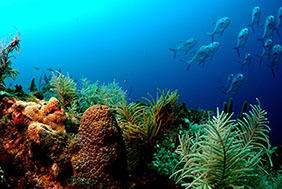-
Home
-
Data & Publications
-
Regional Portals
- About Regional Portals
- Florida
- Navassa Island
- Puerto Rico
- Flower Garden Banks
- U.S. Virgin Islands
- American Samoa
- Commonwealth of the Northern Mariana Islands
- Federated States of Micronesia
- Guam
- Main Hawaiian Islands
- Republic of the Marshall Islands
- Northwestern Hawaiian Islands
- Republic of Palau
- Pacific Remote Island Areas
-
CRCP Activities
- Glossary
Relative resilience potential and bleaching severity in the West Hawaii Habitat Focus Area in 2015

The NOAA Coral Reef Conservation Program (CRCP), NOAA Habitat Blueprint, and Sentinel Site Program have an overlapping Focus Area on the west side of the Island of Hawaii that includes the South Kohala coastline. Coral reefs are of critical importance to the communities and environment of West Hawaii, and supporting the resilience of reefs is a goal within many management plans in the area. Coral reef resilience is the capacity of a reef to resist or recover from degradation and maintain provision of ecosystem goods and services. Resilience-based management of coral reefs can include assessing spatial variation in resilience potential and then targeting and tailoring appropriate actions to preserve or restore resilience. Such assessments involve measuring or assessing resilience indicators (e.g., coral disease, coral recruitment and herbivorous fish biomass) and producing an aggregate score that expresses resilience potential for all sites as relative to the site with the highest (assessed) resilience potential.
The CRCP project team assessed the relative resilience potential of reef sites at two depths along priority areas of South Kohala and North Kona in October of 2015. The surveys were conducted as a collaborative effort with the Hawaii Division of Aquatic Resources (DAR), The Nature Conservancy, SymbioSeas, NOAA Coral Reef Ecosystem Program, and community organizations. While conducting the resilience surveys, the project team also assessed coral bleaching prevalence and severity as well as coral disease prevalence. This report presents results from the resilience and bleaching surveys, which forms year 1 of a 2-year project. During Year 2 (Jan -Dec 2017) the team will use the resilience analysis outputs to identify, discuss (with stakeholders and community members), and prioritize recommended potential management actions to support the resilience of coral reefs in the Focus Area.
Acknowledgements: Financial support for this applied research was provided by the NOAA Coral Reef Conservation Program, matched by contributions from The Nature Conservancy and SymbioSeas. The Hawaii Division of Aquatic Resources helped support the fieldwork. The authors thank the Moana Ohana LLC for field support, and all those that assisted with fieldwork. The contents of this report are solely the opinions of the authors and do not constitute a statement of policy, decision, or position on behalf of NOAA or the U.S. Government.
Citation: Maynard, J., Conklin, E., Minton, D., Most, R., Couch, C., Williams, G.J., Gove, J., Schumacher, B., Walsh, W., Martinez, J., Harper, D., Jayewardene D., Parker, B., Watson, L. 2016. Relative resilience potential and bleaching severity in the West Hawaii Habitat Focus Area in 2015. Silver Spring, MD: NOAA Coral Reef Conservation Program. NOAA Technical Memorandum CRCP 26, 53 pp. DOI: 10.7289/V5T43R4Z
Relative resilience potential and bleaching severity in the West Hawaii Habitat Focus Area in 2015: (full report, pdf 15.1 MB)
For more information, contact:


